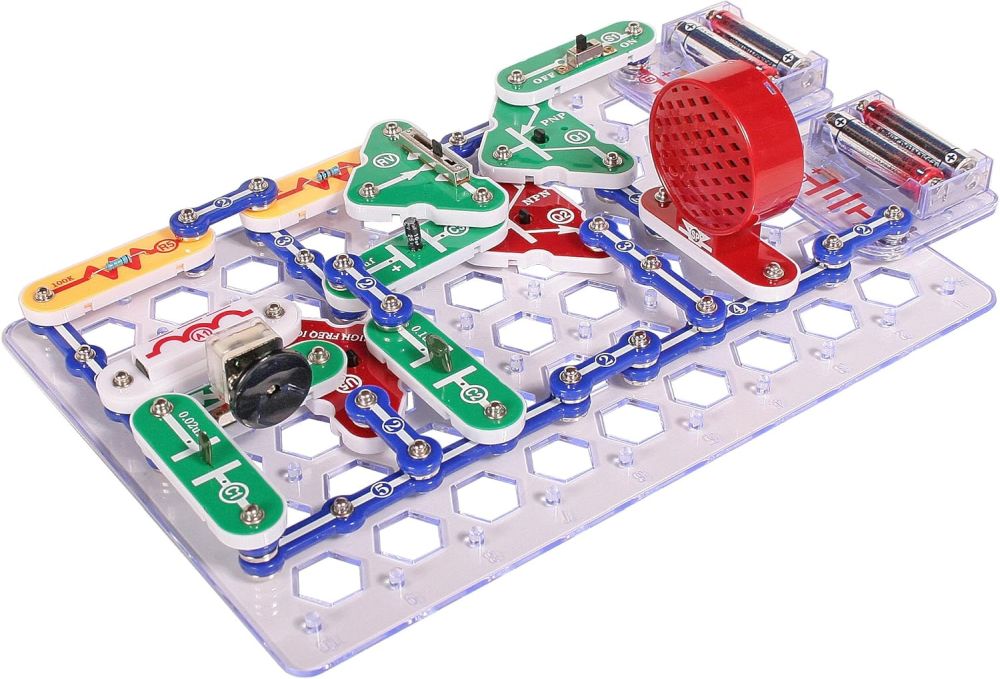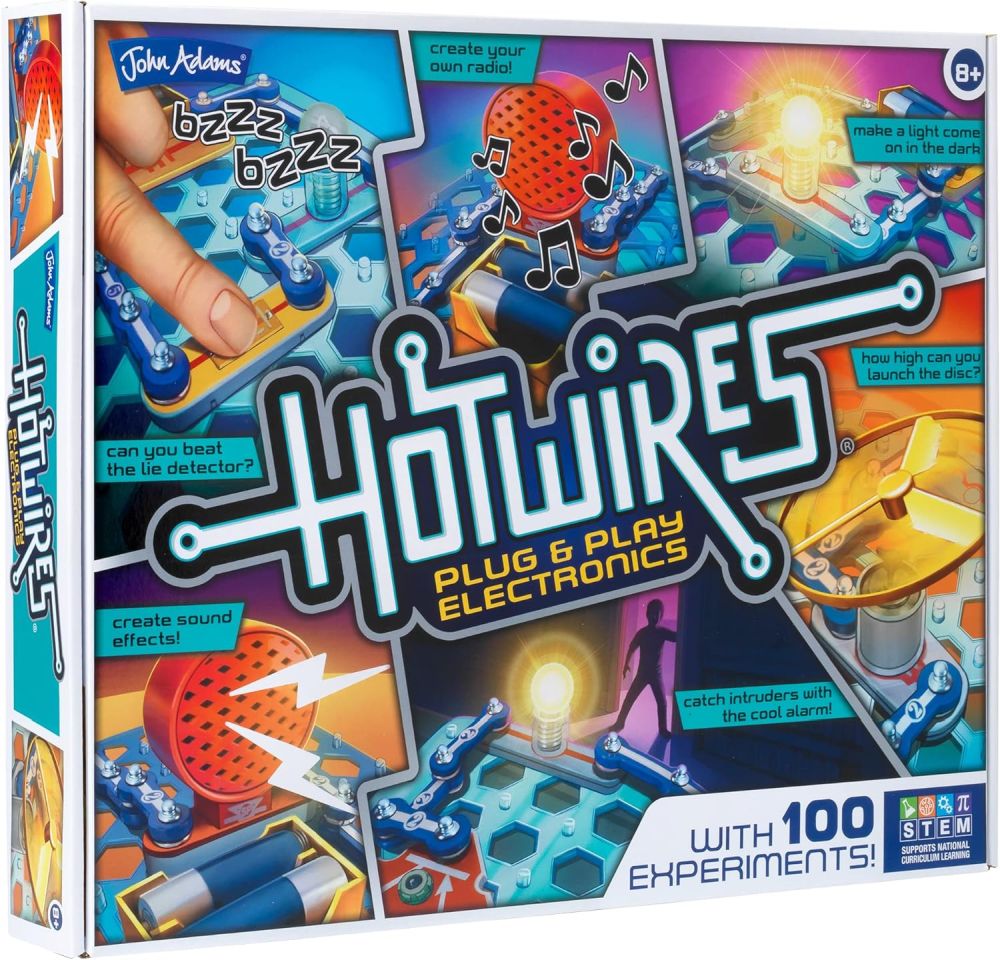Education is fun and you are never too old (or too young) to learn new things. Learning new skills, facts, information etc. should be encouraged at all ages. Some may argue that children already spend around 6 hours at school every day learning new things and may even get homework so when out of school they should be able to relax and have fun. That is true, but why can’t they relax and have fun whilst learning more (and without them even knowing it) with the use of educational toys, games and science kits? One such kit that is lots of fun and supports STEM and the National Curriculum learning is the Hot Wires Electronics Set from John Adams.
The Hot Wires Electronics Set is a plug & play, snap together electronics set. It has no wires to strip or solder, users just snap the components together to build their circuit. The snap together components make is so much easier for little hands to build fully working circuits independently (and much more safety too). The Hot Wires set allows you to create circuits such as a lie detector test, a burglar alarm, spinning disk, a working FM radio and lots more fun experiments – 100 in fact.
The Hot Wires Electronics Set is a 67-piece reusable set. It’s easy to follow full-colour instruction book features 100 experiments and circuits to build involving light, sound and movement, all supporting the National Curriculum. It is suitable for children aged 8 and upwards, is exciting and fun and has the bonus of helping to supplement what children will learn at school.
On opening the box, all the components are neatly laid out. All the different types of components are fitted into their own individual slots so that you can see at a glance what pieces you have. It is a comprehensive kit with a transparent assembly workstation, connectors, buzzer, touch plate, photo resistor, LEDs, battery units, loudspeaker, music IC, alarm IC, sound IC, motor unit, propellor, antenna coil, lamp, bulb, microphone, power amp IC, resistors, capacitors, transistors, diodes and a full colour instruction booklet. It does require 4x AA batteries, which are not included. The instructional booklet also gives you a full list of the components, with pictures of each component and how many of each piece. All components are colour coded and numbered so that you can clearly match to the diagrams in the book. It is a fun kit that guides you into the wonderful world of electronics.
With 100 fun STEM electronic experiments in the instructional booklet, there are plenty to go at. But where to start? Do you make a burglar alarm, a lie detector or maybe launch a spinning disc? It is probably best to start at the beginning as the booklet isn’t just an assembly guide, it does give information on how circuits work and how electricity flows etc.
The first experiment in the booklet is Making a Simple Circuit. This is something I remember doing at school – using a switch to turn on/off a small light bulb. It introduces circuity on a switch to turn on a light and off again, something we all do every day when we enter or leave a room.
All the components are ‘snapped’ on to a plastic board (which is supplied) and then the components snap together to join up together to complete a circuit. This is very straightforward and by following the simple colourfully illustrated picture diagram quite easily. By building this simple circuit and using the information in the book, it shows how electricity flows and how opening or closing a circuit will give a result, in this case turning on or off the light.
As you work your way through the experiments, testing conductivity, making LED circuits and charging a capacitor among them, the experiments get more complicated adding in resistors of varying strengths, different types of switches and sensors and even sounds.
As the experiments become more complex, so do the circuits. You start to add on sound IC units for burglar alarms and lie detectors (requires moisture on a sensor) and light sensitive photo resistors. You will eventually start to create logic circuits, introducing binary and how computers work.

I am very impressed with this set, especially the further that you you progress through the book, the experiments get more challenging, adding in new components and more complicated designs. This sees circuits go from a switch to circuits activated by touch, noise, water and light giving results in sirens, flashing lights, flying discs and even sound effects.
It a world packed with technology, understanding how electronics work is a vital part of children’s scientific education and this set is a great introduction into that. But it also teaches more than that – it also helps with problem solving, critical and logic thinking when something doesn’t work as it should – where did it go wrong and what can be corrected to fix it. It also teaches patience, being meticulous, how to read and follow diagrams and instructions, and having a clear thought process.
Overall, I think that the Hot Wires Electronics Set is an excellent educational kit and lots of fun. The snap together pieces are the perfect introduction for getting children interested in the world of electronics. Snapping together the pieces removes the frustration of stripping wires and soldering onto boards and other components plus makes everything reusable time and time again. It gives children the basic tools to understand how circuits and electricity work in a simple format, giving them the confidence, ability and understanding to move up to using printed circuit boards and the delicate components to build a real circuit board.
This is a very good quality set. The components feel tough and durable, they don’t feel flimsy or delicate so will stand up to being snapped together and unsnapped for a long time. You can even purchase the individual components (most are £2 each including postage) from the John Adams website if you do manage to damage or lose one.
The experiments in the book are lots of fun and encourage children’s learning in an enjoyable way. With making Morse Code generators, simple radio sets, flashing lamps etc. there is a lot to try out in an entertaining way as you can test out lie detectors on your friends, listen to different radio stations, fly discs around the room and more.
This is an excellent set for children and even as an adult I have loved doing some of them (they are very interesting and you’re never too old to learn). We have had some mishaps along the way with blown fuses, but that also adds to the learning experience, especially when trying to come up with your own experiments or fault finding to try and find why it went wrong.
If you want to help further your children’s education at home that goes beyond phonics, reading and maths then Hot Wires is the perfect set to encourage their scientific learning. Who knows, you may just find that you have a budding inventor or electrical engineer in the house. It is also an excellent activity for you to join in with them as well and spend some quality time together.
I would have to give this electronics set 5 stars for its ease of use, quality components, durability, and fun educational value. The Hot Wires Electronics Set is education in a fun, practical way that encourages creative and logical thinking, develops problem solving skills and helps children read and follow electrical diagrams. And its safe to use with no tools or hot soldering irons needed.
Rating: 5/5
RRP: £49.99
For more information, visit www.johnadams.co.uk. Available to buy from Amazon here.

